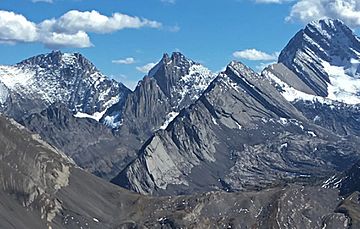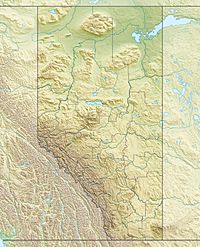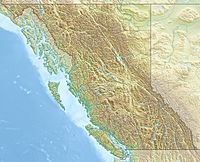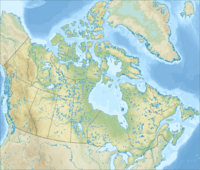Mount Robertson facts for kids
Quick facts for kids Mount Robertson |
|
|---|---|

Mount Robertson (centered) between Mount Sir Douglas dominating the right side and Mount French to the left side
|
|
| Highest point | |
| Elevation | 3,177 m (10,423 ft) |
| Prominence | 281 m (922 ft) |
| Listing | Mountains of Alberta Mountains of British Columbia |
| Geography | |
| Country | Canada |
| Provinces | Alberta and British Columbia |
| Topo map | NTS 82J/11 |
| Climbing | |
| First ascent | 1928 J.W.A. Hickson and Edward Feuz Jr. |
Mount Robertson is a tall mountain located in the Canadian Rockies. It stands right on the border between the Canadian provinces of British Columbia and Alberta. This mountain is found between two mountain passes, Palliser Pass and North Kananaskis Pass. The side of the mountain in British Columbia is part of Mount Assiniboine Provincial Park.
The mountain was named after Sir William Robertson (1860–1933). He was an important military leader during the First World War. From 1916 to 1918, he served as the Chief of the Imperial General Staff, which was a very high-ranking position in the British Army.
Exploring Mount Robertson's Rocks
Mount Robertson is made up of sedimentary rock. This type of rock forms from layers of sand, mud, and tiny bits of plants and animals that settle over millions of years. These layers were laid down in shallow seas during ancient times, from the Precambrian to the Jurassic periods.
Later, during a major mountain-building event called the Laramide orogeny, these rock layers were pushed and folded. They were moved eastward and even slid over younger rocks. To the south of Mount Robertson, you can find the Haig Glacier. This is the largest single glacier in the area known as Kananaskis Country.
Understanding Mount Robertson's Weather
The weather at Mount Robertson is known as a subarctic climate. This means it has very cold and snowy winters. The summers, however, are usually mild.
Temperatures in this region can drop below −20 °C (which is −4 °F). When you add the wind chill factor, it can feel even colder, sometimes below −30 °C (−22 °F). This makes the mountain a very chilly place in winter!




